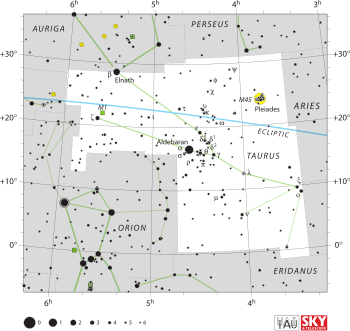Star in the constellation Taurus
10 Tauri is a single[ 9] star in the zodiac constellation of Taurus . It can be seen with the naked eye, having an apparent visual magnitude of 4.29.[ 2] parallax shift of 71.62[ 1] mas provides a distance estimate of 45.5 light years . It is moving further from the Sun with a radial velocity of +28 km/s[ 4] proper motion .[ 2]
The star has a stellar classification of F8 V,[ 3] F-type main-sequence star that is generating energy through hydrogen fusion in its core region . It is around 5.7[ 6] [ 8] mass of the Sun and 1.6 times the Sun's radius . It is radiating three[ 6] Sun's luminosity from its photosphere at an effective temperature of 6,000 K.[ 7]
A debris disk has been identified orbiting 10 Tauri, based on excess infrared radiation detected by IRAS/ISO.[ 10]
10 Tauri was the brightest star in the obsolete constellation Psalterium Georgii (Harpa Georgii).[ 11]
References
^ a b c d e f van Leeuwen, F. (2007). "Validation of the new Hipparcos reduction" . Astronomy and Astrophysics . 474 (2): 653– 664. arXiv :0708.1752 Bibcode :2007A&A...474..653V . doi :10.1051/0004-6361:20078357 . S2CID 18759600 . Vizier catalog entry ^ a b c d e Cowley, A. P.; et al. (December 1967), "Spectral classification and photometry of high proper motion stars", Astronomical Journal , 72 : 1334−1340, Bibcode :1967AJ.....72.1334C , doi :10.1086/110413 ^ a b Houk, N.; Swift, C. (1999), "Michigan catalogue of two-dimensional spectral types for the HD Stars", Michigan Spectral Survey , 5 , Bibcode :1999MSS...C05....0H . ^ a b Nordström, B.; et al. (May 2014), "The Geneva-Copenhagen survey of the Solar neighbourhood. Ages, metallicities, and kinematic properties of ~14000 F and G dwarfs", Astronomy and Astrophysics , 418 : 989– 1019, arXiv :astro-ph/0405198 Bibcode :2004A&A...418..989N , doi :10.1051/0004-6361:20035959 , S2CID 11027621 . ^ a b Pizzolato, N.; Maggio, A.; Sciortino, S. (September 2000), "Evolution of X-ray activity of 1-3 Msun late-type stars in early post-main-sequence phases", Astronomy and Astrophysics , 361 : 614– 628, Bibcode :2000A&A...361..614P ^ a b c Boyajian, Tabetha S.; et al. (February 2012), "Stellar Diameters and Temperatures. I. Main-sequence A, F, and G Stars", The Astrophysical Journal , 746 (1): 101, arXiv :1112.3316 Bibcode :2012ApJ...746..101B , doi :10.1088/0004-637X/746/1/101 , S2CID 18993744 ^ a b c d Soubiran, C.; Creevey, O. L.; Lagarde, N.; Brouillet, N.; Jofré, P.; Casamiquela, L.; Heiter, U.; Aguilera-Gómez, C.; Vitali, S.; Worley, C.; de Brito Silva, D. (2024-02-01). "Gaia FGK benchmark stars: Fundamental Teff and log g of the third version". Astronomy and Astrophysics . 682 : A145. arXiv :2310.11302 Bibcode :2024A&A...682A.145S . doi :10.1051/0004-6361/202347136 . ISSN 0004-6361 . 10 Tauri's database entry at VizieR .^ a b Maldonado, J.; et al. (October 2010), "A spectroscopy study of nearby late-type stars, possible members of stellar kinematic groups", Astronomy and Astrophysics , 521 : A12, arXiv :1007.1132 Bibcode :2010A&A...521A..12M , doi :10.1051/0004-6361/201014948 , S2CID 119209183 ^ Rodriguez, David R.; et al. (May 2015), "Stellar multiplicity and debris discs: an unbiased sample", Monthly Notices of the Royal Astronomical Society , 449 (3): 3160– 3170, arXiv :1503.01320 Bibcode :2015MNRAS.449.3160R , doi :10.1093/mnras/stv483 ^ J.S. Greaves; D.A. Fischer; M.C. Wyatt (2006). "Metallicity, Debris Discs and Planets" . Monthly Notices of the Royal Astronomical Society . 366 (1): 283– 286. Bibcode :2006MNRAS.366..283G . doi :10.1111/j.1365-2966.2005.09848.x ^ Ian Ridpath's Star Tales - Psalterium Georgii
External links
